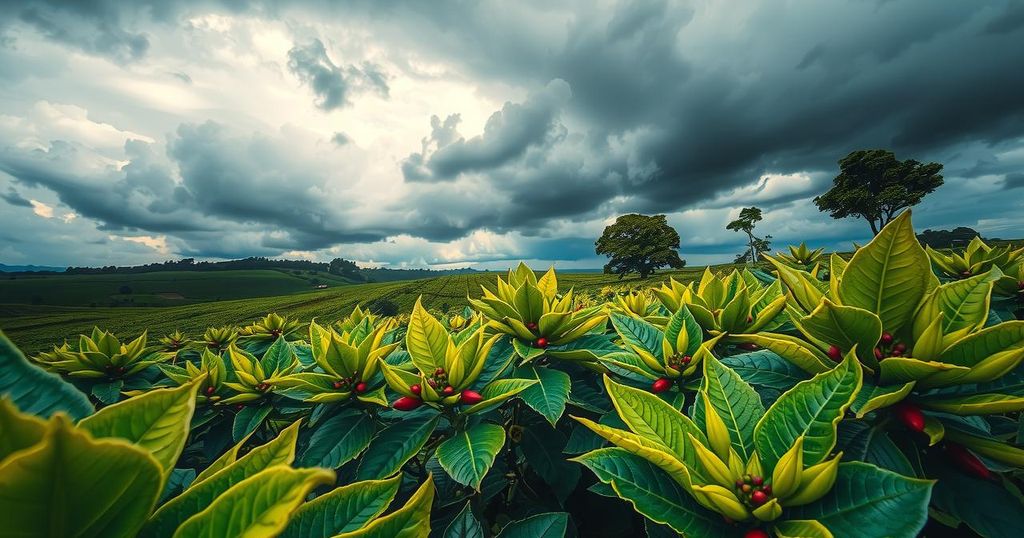Arabica Coffee Prices Rise Amidst Weather Challenges in Brazil
Arabica coffee prices have risen due to adverse weather in Brazil, threatening coffee yields. In contrast, robusta coffee prices declined following increased inventories. Meanwhile, global coffee supply faces challenges, with Brazil expecting reduced production and exports in the coming years, while Vietnam’s robusta output remains under pressure.
Coffee prices have demonstrated a mixed trend today, with arabica coffee reaching a two-week high, while robusta coffee saw a decline. The increase in arabica prices is attributed to adverse weather conditions in Brazil, which are jeopardizing coffee yields. Somar Meteorologia indicated that Minas Gerais, Brazil’s largest arabica region, received only 30.8 mm of rain last week, which is 71% of the historical average. Additionally, Brazil’s largest arabica coffee cooperative, Cooxupe, noted that high temperatures and insufficient rainfall last month will likely impact coffee yields this year.
In contrast, robusta coffee experienced a downturn after initially gaining ground, attributed to a rise in ICE-monitored robusta coffee inventories, which reached a one-and-a-half week high of 4,336 lots. On the other hand, arabica coffee inventories monitored by ICE fell to a three-and-a-half week low of 782,648 bags. Concerns about supply continue to bolster coffee prices, as Cecafe reported a 12% decline in Brazil’s green coffee exports year-on-year for February, amounting to 3 million bags.
Additionally, Brazil’s government crop forecasting agency, Conab, has projected a 4.4% decrease in the upcoming coffee crop for 2025/26, estimating it at a three-year low of 51.81 million bags. Furthermore, they have revised their 2024 Brazil coffee crop estimate lower by 1.1%, from 54.8 million bags down to 54.2 million bags. Compounding these challenges, Marex Solutions forecasts a widening global coffee surplus for the 2025/26 season.
Robusta coffee pricing is under pressure due to reduced production in Vietnam, the world’s leading robusta producer, which saw a 20% decline in coffee production for the 2023/24 crop year, totaling 1.472 million metric tons. The USDA’s Foreign Agricultural Service (FAS) has projected a slight dip in Vietnam’s robusta coffee production for the upcoming marketing year, alongside a notable reduction in coffee exports.
The recent trends in US and global coffee exports reveal contrasting strategies. Brazil has increased its coffee exports for 2024 by 28.8%. However, the International Coffee Organization noted a significant decline in global coffee exports, indicating a complicated balance between production and demand. The USDA reported a mixed forecast for coffee prices, estimating a 4% increase in world coffee production for 2024/25, alongside a projected drop in ending stocks to a 25-year low.
Moreover, projections for the 2025/26 marketing year have been recently adjusted. Volcafe revised Brazil’s arabica coffee production estimate downward significantly, predicting a deficit of 8.5 million bags, a continuation of the trend seen in previous years. The analysis illustrates an ongoing crisis in coffee production affecting both arabica and robusta varieties across the globe, primarily driven by climatic conditions and agricultural challenges.
In summary, arabica coffee prices have surged due to adverse weather conditions in Brazil, contributing to concerns over reduced yields. In contrast, robusta coffee prices have declined following an increase in inventories. The ongoing imbalance in global coffee supply and demand poses a complex landscape for coffee prices, with forecasts indicating further challenges ahead in both production and inventory levels. The continuous adverse climatic impact on coffee cultivation underlines the significant risk factors facing the coffee market in the coming years.
Original Source: www.nasdaq.com




Post Comment